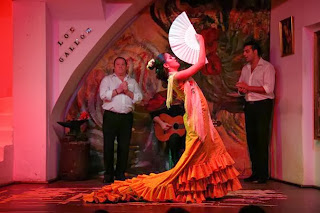En el siglo XVIII, y concretamente en Andalucía, fue cuando nació uno de los estilos de música y danza más internacionales que existen y que se ha convertido en uno de los mejores embajadores de España: el flamenco.
Como Patrimonio Cultural Inmaterial de la Humanidad está catalogado aquel que cuenta con una amplia diversidad de variedades, fundamentalmente en lo que se refiere al cante. Es decir, que posee un extenso número de palos. No obstante, entre los más significativos se encuentran los siguientes:
- Fandangos, caracterizados por sus variaciones instrumentales y su alternancia de letras.
- Tango: Sus versos octosílabos son los que identifican a aquel que se ha convertido en uno de los palos del flamenco más importantes.
- Soleares, identificadas por sus letras relativas a desengaños o a la soledad donde toman protagonismo los versos de arte menor.
- Alegrías: Dentro de los conocidos cantes de Cádiz se encuentra aquellas que sobresalen por su melodía festiva, sus versos octosílabos y su tempo rápido. De la jota navarro-aragonesa parece que procede este palo del flamenco en el que destacan grandes figuras del cante como Chano Lobato.
- Bulerías: En Jerez de la Frontera es donde nacieron y desarrollaron aquellas que se caracterizan por su marcado aire alegre y festivo así como por el hecho de que suelen interpretarse en el llamado modo dórico, en lo que a tonalidad se refiere. José Mercé, el gran Camarón de la Isla o La Paquera de Jerez son los intérpretes que encumbraron a las bulerías a la cima del flamenco.
- Peteneras: Totalmente opuesto al anterior palo se encuentra este que se caracteriza por tener letras muy tristes y melancólicas que se cantan a ritmos muy lentos.
- Sevillanas: Por supuesto, dentro del flamenco tampoco hay que olvidarse de aquellas que son típicas de Sevilla y que suelen ser las protagonistas de ferias y romerías.

